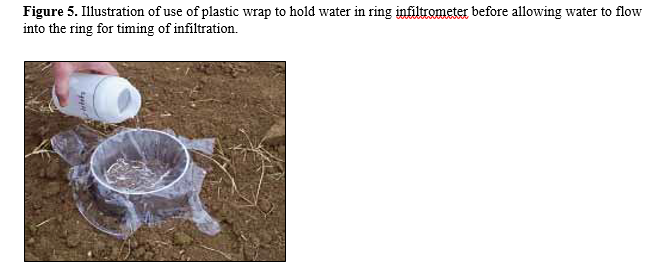You are here
Water Infiltration Rate
Infiltration rate is a measure of the speed at which water moves into soil, i.e., how rapidly it enters the soil. A soil with slow infiltration leads to water ponding and soil saturation, which deprives crops of oxygen. On a sloped site, slow infiltration leads to erosion from surface runoff of water that can’t soak in. Good infiltration is important for capture and retention of water and to recharge soil moisture.
How to operationalize the metric
Method of data collection and data needed to compute the method:
A ring infiltrometer is the simplest method to measure water infiltration in the field. In the field, improved measurements can be obtained using a sprinkler infiltrometer (Thierfelder and Wall, 2009) or the stick method (https://jornada.nmsu.edu/monit-assess/manuals/monitoring).
As well, there are lab methods using intact soil cores; however, these methods are complex and time consuming. It is important to be aware the soil surface infiltration tends to be highly variable, as the surface roughness and pore distribution is often very heterogeneous. Obtaining multiple infiltration measurements across a field site is one way to address this challenge, suggesting a simple, relatively rapid method is useful as it allows more replications to be completed.
Before beginning, practice driving the ring infiltrometer into the soil without disturbing the soil surface. Using the graduated cylinder, pour water into the infiltrometer and note that the water “ponds” within the ring. Select a penetration depth and ponding level that will be maintained for each repetition of the measurement. Recommendations: A 12.5cm diameter ring, a 3cm installation depth into soil, and water added to a depth of 3cm in the ring.
- Select a representative site, one that has no large cracks. Trim any vegetation close to the surface and move aside any residues for a clear surface. Pre-wet the soil to a depth of 4cm by laying a pre-moistened cloth towel on the surface and then pouring on – slowly, in multiple small amounts – a cup of water (about 370ml). Wait a few minutes then apply a second cup in the same manner (an additional 370ml).
- Drive the infiltrometer ring into the soil to a depth of 3cm (mark the outside). A beveled edge on the ring will help drive it in smoothly, and a piece of wood can be used to evenly distribute the pressure as it is installed. You also can slightly twist it to get it to go into the soil. Test that the ring is securely set in the soil (if it moves around, then insert it another 0.5 cm).
- Checking for leaks and pre-wetting: Add water into the ring without disturbing the surface. This can be accomplished by laying plastic wrap on top of the infiltration ring and slowly removing to allow uniform release of water. Pour about 3cm depth water into the ring (370ml water for a 12.5 cm diameter ring). Check for any signs of visual leaks, if leaks appear, then push the ring in another 0.5 cm. Distilled water or rain water are preferred.
- Measuring infiltration rate: Add another 370 millimeters water to the infiltrometer ring (using the plastic wrap and careful removal as above). Start a stopwatch at the exact moment the wrap is removed and the water is allowed to start infiltrating. Record how long it takes in seconds for the water to infiltrate until about 50% of the soil no longer glistens (is shiny). This is the time it takes for 3cm of water to infiltrate into the soil. This is recorded as mm/min.
Unit of analysis:
To compute infiltration rate, convert the volume of water to a water depth, then divide by the elapsed time it takes for water to completely infiltrate (50% of soil glistens). For example, if it takes 10 minutes for 370ml (3cm depth) of water to infiltrate, then to report the infiltration as cm/sec:
To calculate depth of water:
- A = surface area of the infiltrometer ring. Where radius (r) = half of the ring diameter in centimeters, and π can be looked up in a table or on a calculator.
- Calculate the depth of water infiltrated (H) as the volume of water (V) divided by the surface area (A) of the infiltrometer, where water volume is measured in milliliters (100ml added = 100cm3 because 1 ml = 1 cm3.
- Record the time elapsed in seconds, and calculate the infiltration rate (I) as water depth (H) by time elapsed (t in cm/sec):
Limitations regarding estimating and interpreting:
If the soil is already saturated (flooded) and it is not possible to carry out water infiltration, the soil will have to be allowed to dry for several days before testing infiltration.
This method cannot be used in very sandy, stony, or clayey soils, or on frozen ground. It is important for the ring to not leak, nor to be set over large pores or cracks.
Carrying out multiple infiltration measurements over an area will improve the assessment, as infiltration rate tends to vary markedly over time and space. Using a transect method to select measurement sites and a bottle and pipette to improve test accuracy have been shown to improve the reproducibility as a more quantitative method. However, it is time consuming and the semi-quantitative bottleless method described above used over many locations often provides a more simple and comprehensive description of water infiltration properties (Herrick et al., 2005 or https://jornada.nmsu.edu/monit-assess/manuals/monitoring)


